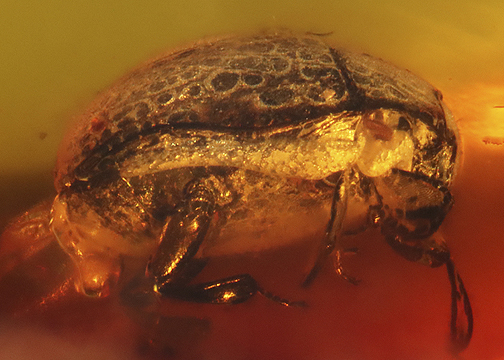Abstract
The polyphagan family of clown beetles (Coleoptera: Histeridae) is represented by over 4,800 species with worldwide distribution. It is well-known for the diversity of exploited habitats and remarkable morphological adaptations, which evolved in relation to habitat shifts (Kovarik & Caterino, 2016). The origin of the family has been estimated to the mid-Jurassic based on phylogenomic analyses (Kusý et al., 2025). The earliest known fossils appeared in the Cretaceous Period, with the oldest fossils from the Lower Cretaceous Hkamti amber (ca. 110 Ma) of northern Myanmar (Caterino & Yamamoto, 2023; Simon-Pražák et al., 2024). There are currently over 50 described fossil species of clown beetles with most of them found in Cretaceous and Eocene ambers. Only a single species has been formally described from the Miocene age ambers (i.e., Trypanaeus hispaniolus Chatzimanolis et al., 2006; from Middle Miocene Dominican amber of the Dominican Republic).
References
- Caterino, M.S. (2021) New fossil histerid species from Cretaceous Burmese amber (Coleoptera: Histeridae). The Coleopterists Bulletin, 75 (1), 211–221. https://doi.org/10.1649/0010-065X-75.1.211
- Caterino, M.S. & Yamamoto, S. (2023) New onthophiline fossil species (Coleoptera: Histeridae: Onthophilinae) from mid-Cretaceous Burmese amber. The Coleopterists Bulletin, 77 (3), 432–438. https://doi.org/10.1649/0010-065X-77.3.432
- Chatzimanolis, S., Caterino, M.S. & Engel, M.S. (2006) The first fossil of the subfamily Trypanaeinae (Coleoptera: Histeridae): A new species of Trypanaeus in Dominican amber. The Coleopterists Bulletin, 60 (4), 333–340. https://doi.org/10.1649/0010-065X(2006)60[333:TFFOTS]2.0.CO;2
- Gyllenhal, L. (1808) Insecta Suecica descripta. Classis I. Coleoptera sive Eleuterata. Tomus I. F.J. Leverentz, Scaris, xii + 572 pp (In Latin). https://doi.org/10.5962/bhl.title.8767
- Horn, G (1873) Synopsis of the Histeridae of the United States. Proceedings of the American Philosophical Society, 13, 273–357.
- Jiang, R.X., Caterino, M.S. & Chen, X.S. (2022) Discovery of the genus Anapleus Horn, 1873 from Cretaceous Kachin amber (Coleoptera: Histeridae). Insects, 13 (8), 746. https://doi.org/10.3390/insects13080746
- Kovarik, P.W. & Caterino, M.S. (2016) 13.3 Histeridae Gyllenhal, 1808. In: Beutel R.G. & Leschen R.A.B. (Eds), Handbook of Zoology. Vol. 1, Coleoptera, beetles. morphology and systematics. 2nd ed. Walter de Gruyter, Berlin, Boston, pp. 273–314. https://doi.org/10.1515/9783110373929-016
- Kusý, D., Motyka, M., Simon-Pražák, J., Lackner, T., Prokin, A. & Fikáček, M. (2025) Phylogenomics resolves the relationships among Hydrophiloidea-Histeroidea families (Coleoptera) and challenges the single colonization of aquatic habitats. Systematic Entomology, 50 (4), 813–835. https://doi.org/10.1111/syen.12679
- Matzke-Karasz, R., Serrano-Sánchez, M.D.L., Pérez, L., Keyser, D., Pipík, R. & Vega, F.J. (2019) Abundant assemblage of Ostracoda (Crustacea) in Mexican Miocene amber sheds light on the evolution of the brackish-water tribe Thalassocypridini. Historical Biology, 31 (2), 65–101. https://doi.org/10.1080/08912963.2017.1340471
- Mazur, S. (2011) A concise catalogue of the Histeridae (Insecta: Coleoptera). Warsaw University of Life Sciences-SGGW Press, Warsaw, 332 pp.
- Ôhara, M. (1994) A revision of the superfamily Histeroidea of Japan [Coleoptera]. Insecta Matsumurana, 51, 1–283.
- Olexa, A. (1982) Revision der paläarktischen Arten der Gattung Anapleus (Coleoptera, Histeridae). Acta Entomologica Bohemoslovaca, 79, 37–45.
- Reitter, E. (1909) Fauna Germanica. Die Käfer des Deutschen Reiches. Nach der analytischen Methode bearbeitet. II Band. Schriften des Deutschen Lehrervereins für Naturkunde 24. K.G. Lutz, Stuttgart, 392 pp., pls. 41–80.
- Simon-Pražák, J., Fikáček, M., Prokop, J. & Lackner, T. (2023) Under the Cretaceous bark: Fossil evidence for the ancient origin of subcortical lifestyle of clown beetles (Coleoptera: Histeridae). Arthropod Systematics & Phylogeny, 81, 439–453. https://doi.org/10.3897/asp.81.e102404
- Simon-Pražák, J., Yamamoto, S., Lackner, T., Fikáček, M., Prokop, J. & Caterino, M.S. (2024) A bonanza of Cretaceous fossils provides insights into the evolution of antennal protection in clown beetles (Coleoptera: Histeridae). Zoological Journal of the Linnean Society, 202 (3), zlae137. https://doi.org/10.1093/zoolinnean/zlae137
- Solórzano Kraemer, M.M. (2007) Systematic, palaeoecology, and palaeobiogeography of the insect fauna from Mexican amber. Palaeontographica Abteilung A, 282, 1–133. https://doi.org/10.1127/pala/282/2007/1
- Solórzano Kraemer, M.M. (2010) Mexican amber. In: Penney, D. (Ed.), Biodiversity of fossils in amber from the major world deposits. Siri Scientific Press, Manchester, pp. 42–56.


